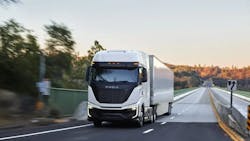Nikola's Q3 results: The good, the bad, and the interesting
Nikola Corporation’s third quarter results were full of good and bad news. From increased deliveries to record hydrogen refueling numbers, the startup seems to be trucking along nicely, but impacted revenue and more are dragging it down. While they continue to roll out the fuel cell trucks and draw fleet attention, Nikola executives stressed that the nascent OEM is still focused on its battery-electric powertrain system to complement its alternative fuel offerings.
The good
Truck sales continue to be healthy for Nikola, with the company wholesaling 88 hydrogen fuel cell electric vehicles, a 22% jump from Q2. CEO Steve Girsky affirmed that his team planned to keep the guidance volume of 300 to 350 trucks. Year-to-date, they have sold roughly 200.
There aren’t just more Nikola trucks on the road, they’re going out further and more often as well. According to Girsky, the number of runs exceeding 400 miles with the trucks jumped nearly 50% to 285 during the quarter.
“[A]s fuel availability increases, and fleet operators get more comfortable with the technology, they are pushing the fuel cell electric vehicle to perform the way it is built to,” he said.
The same is true for Nikola’s battery-electric trucks. To date, the company has returned 78 of the vehicles to owners’ hands, cutting the backlog in half. Since the BEV 2.0 has been back on the road, the average distance between charging increased from 130 miles to 143 miles, with nearly one-third of all runs exceeding 200 miles.
The fueling side of Nikola is also doing well: Girsky and his team expect to deliver 10 Hyla refueling stations by year-end. This year, total hydrogen dispensing at the locations has grown 350%.
See also: Nikola CEO: “We're all in, and there's no turning back.”
The bad
Overall, Nikola’s revenue did fine in Q3, coming in at $33 million and beating last quarter’s record $31 million. The figure, which executives attributed to increased wholesale deliveries, would have been better if not for an $8 million repurchase of 20 BEVs that impacted net earnings. Girsky said they viewed the impact as a “timing event,” as they have a “[purchase order] in hand” to deliver the units to another dealer.
Revenue wasn’t the only problem in Nikola’s financials: Average sale price was down 7% to $361,000, and loss ballooned to $62 million versus $55 million in Q2, with the BEV returns also impacting that number.
Nikola ended the quarter with $198 million in cash; enough to meet obligations into Q1 2025, but not beyond that, according to CFO Tom Okray. He also stressed that they are “examining every opportunity” to optimize cash.
What “every opportunity” looks like is still unclear, though, as Okray and Girsky declined to comment on the specifics of their capital raise plans. Okray did say that they had talked to a number of “strategics” and that there were people interested.
Girsky also said that they were looking at partners that “value” what Nikola does and has built so far; even mentioning he wanted to help build a “coalition” of like-minded companies wanting to pursue zero-emission technology.
Okray expanded on the point, specifying they had searched for partners with stated, corporate-wide decarbonization goals for the next decade.
Some of the work is also internal; the company’s cash conversion cycle, the amount of time it takes to turn inventory into cash from sales, shortened by 45 days since the beginning of 2024. Other actions Okray outlined included working on voucher processing, dealer floor planning issues, and organization structure reviews.
The interesting
For the most part, Q4 will be more of the same for Nikola: reaffirmed guidance, building more Hyla refueling, and adding to the network.
But, Girsky also reiterated that Nikola isn’t just about its hydrogen trucks, BEVs still play a role “in most national fleets,” and the company would continue to remanufacture them beyond the recalled units.
“While we believe that the fuel cell truck is the best option for most of our customers' use cases, we also believe that our BEV truck plays a role in most national fleets,” he said.
The re-issued trucks received “overwhelmingly positive” feedback from users, and the leadership team clearly took that to heart, with Girsky also saying that they still plan to sell their inventory next year, roughly 150 vehicles, and even look at making more.
“We've always harped on with one truck platform, two powertrain options, all zero-emission,” Girsky said. “But up till now, we've really only had one or the other in the market, either the BEV or the fuel cell […] So, as we make progress through the recall next year, we are getting a pull from the BEVs and we will start selling [them] from Nikola’s inventory.
The share price for Nikola (Ticker: NKLA) has trended downward over the last three months. Opening at $4.16 per share on Oct. 31, the price dropped as low as $3.80 per share after reporting earnings, closing at $3.93 per share. As of writing, the price is $3.26 per share.
About the Author

Jennifer Ramsay
Jennifer Ramsay is an editor-at-large at Endeavor Business Media. In her role, Ramsay is responsible for curating several of the Market Moves newsletters and keeping tabs on the latest in the world of electric vehicles and clean energy.
